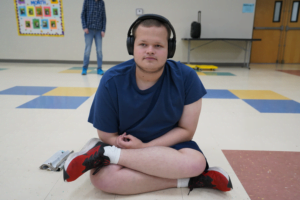Offering Individualized
Educational Programs For K-12 Students
Sensory Processing Awareness Month
October marks Sensory Processing Awareness Month.
This month is all about recognizing and supporting the 1 out of every 20 people with unique sensory needs around the world. Here at Autism Academy we know that all of our students need some kind of sensory support throughout the day.
So what exactly is sensory processing?
Starting in the 1970’s, researchers began to examine the way our brains process information from our different senses. They noted that people with autism and developmental disorders would display increased or decreased sensitivity to light, sound, taste, and even touch. While every person does respond differently, they did identify 2 categories of sensitivity: hyposensitivity and hypersensitivity.
People who are hyposensitive receive less input from their senses. They may not notice them or require a more intense stimulus to respond. People who are hypersensitive receive more input from their senses and may find things that others consider typical to be overwhelming.
Some examples of sensory processing issues can be:
- Covering ears or wearing headphones to reduce noise levels
- Refusing to eat certain foods because of the texture, taste, or smell
- Refusing to wear certain fabrics or types of clothing
- Discomfort from clothing tags
- Using very hot or very cold water to bathe
- Refusing to bathe due to discomfort
- Putting non-edible items in the mouth
- Listening to very loud music, movies, or television shows, often repetitively

Those cover the 5 senses that we all learned about in school, but did you know that researchers have discovered 2 additional senses? Individuals with autism can also experience sensory processing issues with those senses, what are they?
Proprioceptive Input
There is a system of sensors in our bodies that are responsible for something called proprioception. This sense allows the brain to understand where the body is in relation to other objects and how to move. Have you ever noticed that you can actually feel when you are getting too close to something? That is your proprioceptive system hard at work. When this sense is hyposensitive, you may find that the person is always on the move. When they are hypersensitive, they may appear more clumsy as they have difficulty understanding where their body is in space.
People with differences processing proprioceptive input might:
- Flap their arms or hands
- Seek out lots of pressure like bear hugs or heavy blankets
- Be uncomfortable with touch
- Prefer a large amount of personal space
- Be unaware of personal space and bump into people/objects frequently
- Use too much pressure when doing fine motor tasks like writing or erasing
Vestibular Input
Like the proprioceptive system, the vestibular system is a group of receptors (mostly in the inner ear) that help the brain with information about movement and head position. This affects their balance and coordination which can make them seem clumsy as well.
People with differences processing vestibular input might:
- Jump around on the ground or on a trampoline
- Love to ride roller coasters
- Feel calmer after swinging
- Get up to move around at unexpected times
- Rock in their chair
- Be uncomfortable with tasks requiring good balance like climbing or standing on one foot
- Struggle riding a bike
- Have difficulty walking in a straight line
So what can you do to help?
The most important thing to remember is that all people with sensory difficulties respond to their senses differently. What bothers one person may be something another person finds soothing. It is essential that you observe their behaviors and listen to them. For verbal individuals, they can simply tell you what they feel and what they prefer. For less verbal individuals, it may take some meltdowns to figure out what works for them. As someone supporting them, try to be patient and be ready for quite a bit of trial and error.
In addition to doing your best to support, an occupational therapist can be of help. An occupational therapist specializes in helping people to accomplish tasks in their life or occupation. This can include everyday tasks like writing, getting dressed, making meals, and playing with others. It can also include supporting sensory processing needs.
What exactly does an occupational therapist do?
These therapists will work with their clients of any age, their families, and (for children) their schools to determine what services are needed. Sometimes this is working directly with a therapist to learn new skills and learn to cope with sensory difficulties. Other times, the therapist may consult with families and schools so that they can provide the individual with tools to help them process sensory input. After an evaluation by an occupational therapist, schools like Autism Academy offer both direct and consultative services to children and young people who show a need. For public schools, they likely have an occupational therapist on staff that does evaluations. For private schools like Autism Academy, you likely need to have an evaluation done on your own or through your health insurance.
Direct occupational therapy sessions can actually be a lot of fun. Some of the many activities that they do in schools or at home include:
- Cutting and writing activities like crafts
- Playing with playdoh, silly putty, or theraputty
- Play with puzzles or blocks, especially legos
- Practice getting dressed and fastening clothing
- Tying shoes
- Exercises like push-ups, sit-ups, and jumping jacks
- Running or jumping on trampolines
- Heavy work like carrying a full backpack or a stack of books
- Deep pressure activities like squeezing the shoulders and arms
During consultations, an occupational therapist will often recommend special tools or equipment to help families and schools address sensory needs or build skills. This can include:
- Helping to identify the specific sensory needs of an individual
- Recommending special seating like a rocking chair or wobble stool
- Teaching how to give deep pressure massage or apply lotion
- Recommending special writing tools or pencil grips
- Creating a schedule or sensory diet for providing sensory activities
- Adjusting lighting or noise in the environment
- Providing tips to introduce and cope with stimuli that are troublesome but necessary
- Teaching how to replace harmful or stigmatizing sensory processing behaviors with safer or more functional behaviors
As we move through the month of October and into a season that includes lots of different sensory input like costumes, haunted houses, and even trick-or-treating, we encourage you to learn as much as you can about how to support those around you with sensory processing difficulties.
Looking for more information? Try the resources listed below:
The Child Mind Institute: https://childmind.org/article/sensory-processing-issues-explained/
American Occupational Therapy Association: https://www.aota.org
Want to learn more about sensory support and occupational therapies at Autism Academy? Reach out to our enrollment specialist today!



